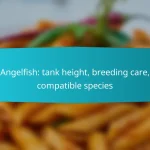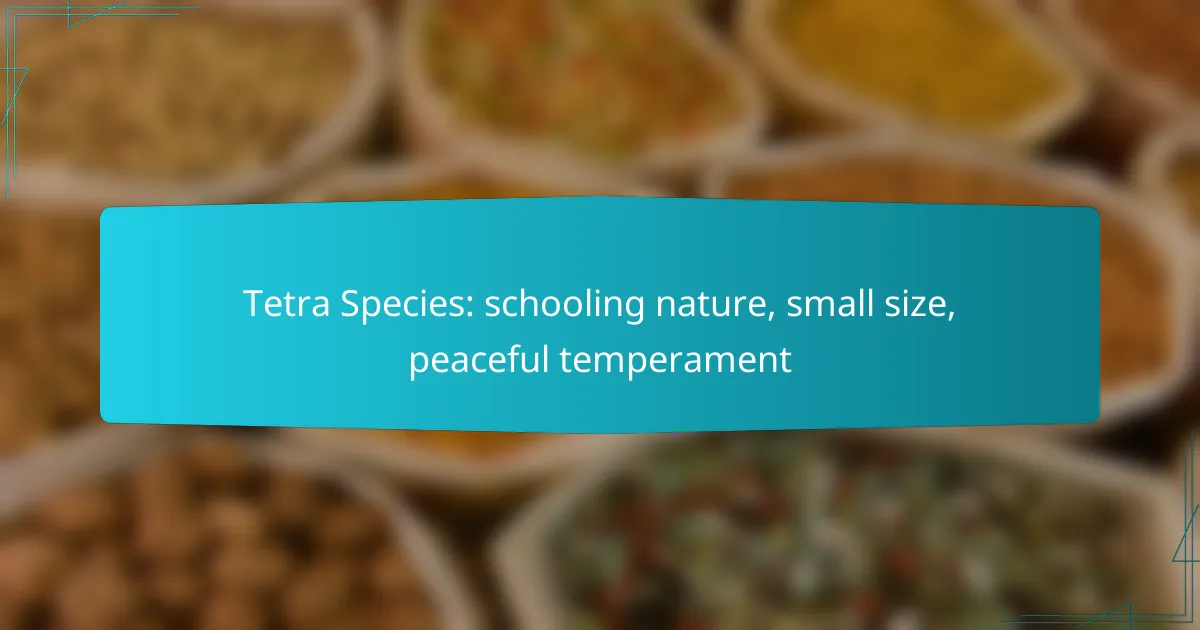Neon Tetras are small, brightly colored fish that make a stunning addition to any community aquarium. Known for their vibrant blue and red stripes, these peaceful creatures thrive in groups and require specific water conditions to flourish. Providing a suitable environment and compatible tank mates is essential for their well-being and overall health.
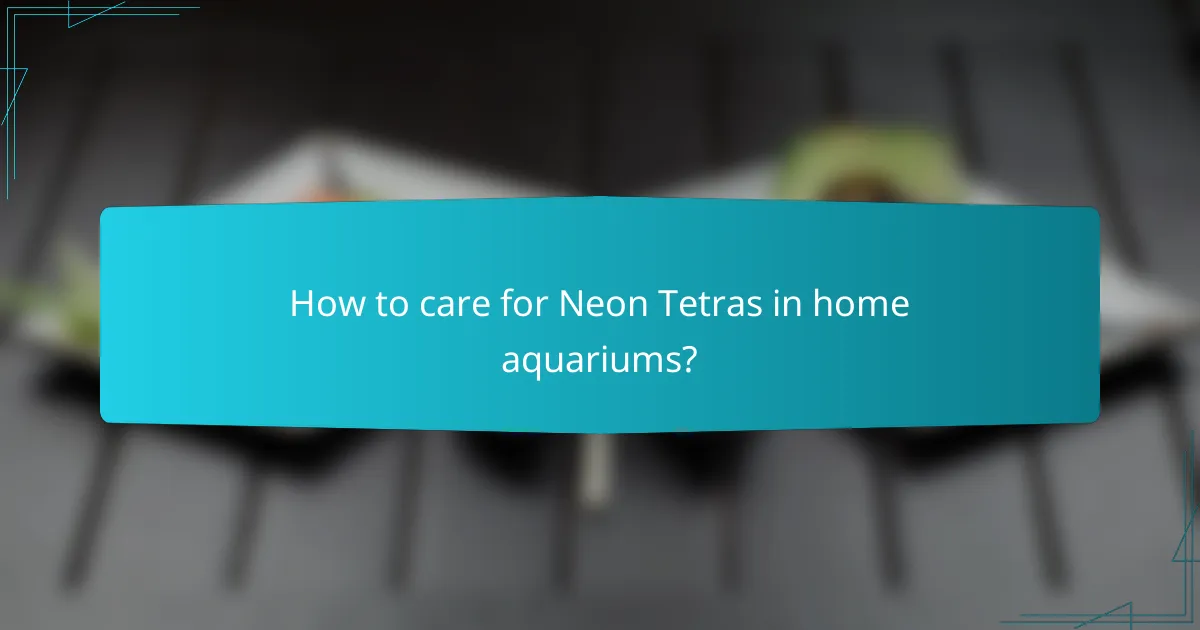
How to care for Neon Tetras in home aquariums?
Caring for Neon Tetras involves providing a suitable environment that mimics their natural habitat, ensuring proper water conditions, and offering a balanced diet. These small, vibrant fish thrive in groups and require specific tank conditions to flourish.
Optimal tank size for Neon Tetras
Neon Tetras are small fish that do best in groups, so a tank size of at least 10 gallons is recommended for a small school of six to eight fish. Larger tanks, such as 20 gallons, allow for more swimming space and better water quality management.
Avoid overcrowding, as this can lead to stress and health issues. Ensure the tank has plenty of plants and hiding spots to create a comfortable environment for these community-friendly fish.
Water parameters for Neon Tetras
Neon Tetras prefer soft, slightly acidic water with a pH range of 6.0 to 7.0. The water temperature should be maintained between 22°C to 26°C (72°F to 78°F) to keep them healthy and active.
Regular water changes of about 25% every two weeks help maintain optimal water quality. Use a reliable water testing kit to monitor parameters like ammonia, nitrite, and nitrate levels, ensuring they stay within safe ranges.
Feeding guidelines for Neon Tetras
Neon Tetras are omnivorous and thrive on a varied diet. High-quality flake food, micro-pellets, and occasional live or frozen foods like brine shrimp or daphnia can provide balanced nutrition.
Feed them small amounts two to three times a day, ensuring they consume everything within a few minutes to prevent overfeeding and water quality issues. Adjust portions based on their activity level and tank conditions.
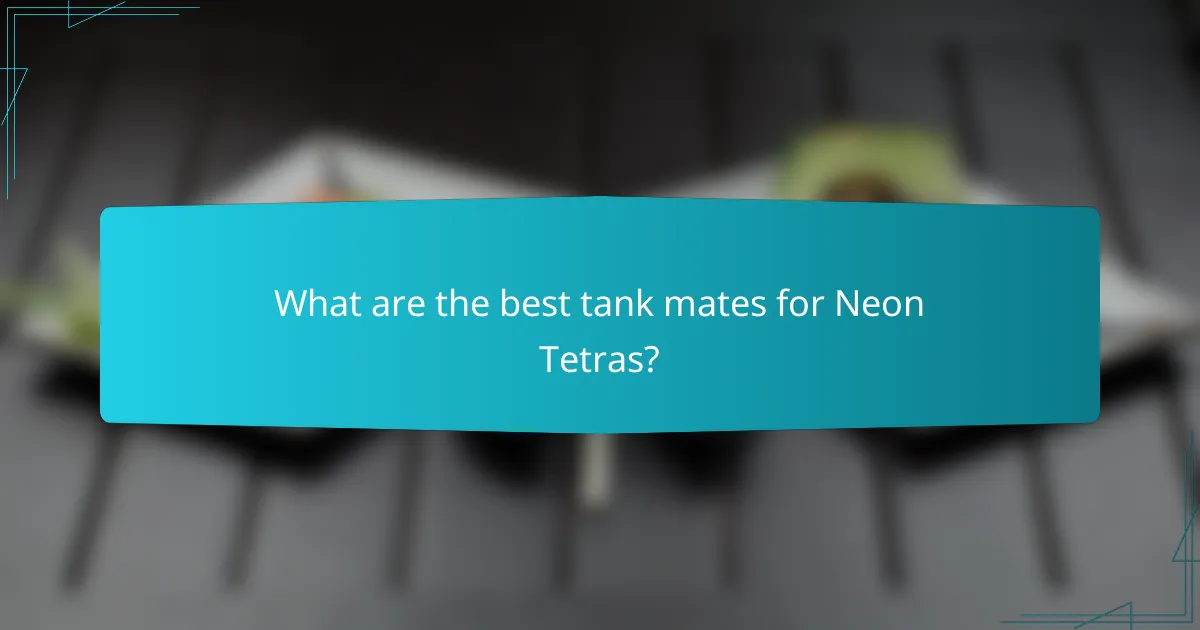
What are the best tank mates for Neon Tetras?
Neon Tetras thrive in community tanks with peaceful fish that share similar water conditions. Ideal tank mates should be small, non-aggressive, and compatible in terms of temperature and pH levels.
Community-friendly fish species
When selecting tank mates for Neon Tetras, consider species like Guppies, Corydoras Catfish, and Endler’s Livebearers. These fish are generally peaceful and can coexist well with Neon Tetras, creating a vibrant community tank.
Additionally, small schooling fish such as Rasboras and other Tetra species work well, as they prefer similar water parameters and social environments. Keeping these fish in groups helps reduce stress and enhances their natural behaviors.
Incompatible species to avoid
Avoid keeping aggressive fish like Cichlids or larger species such as Oscars with Neon Tetras, as they may see them as prey. These fish can disrupt the peaceful environment that Neon Tetras require.
Also, steer clear of fast-swimming species like Barbs, which may harass Neon Tetras and cause undue stress. Maintaining a harmonious tank is crucial for the health and well-being of your Neon Tetras.
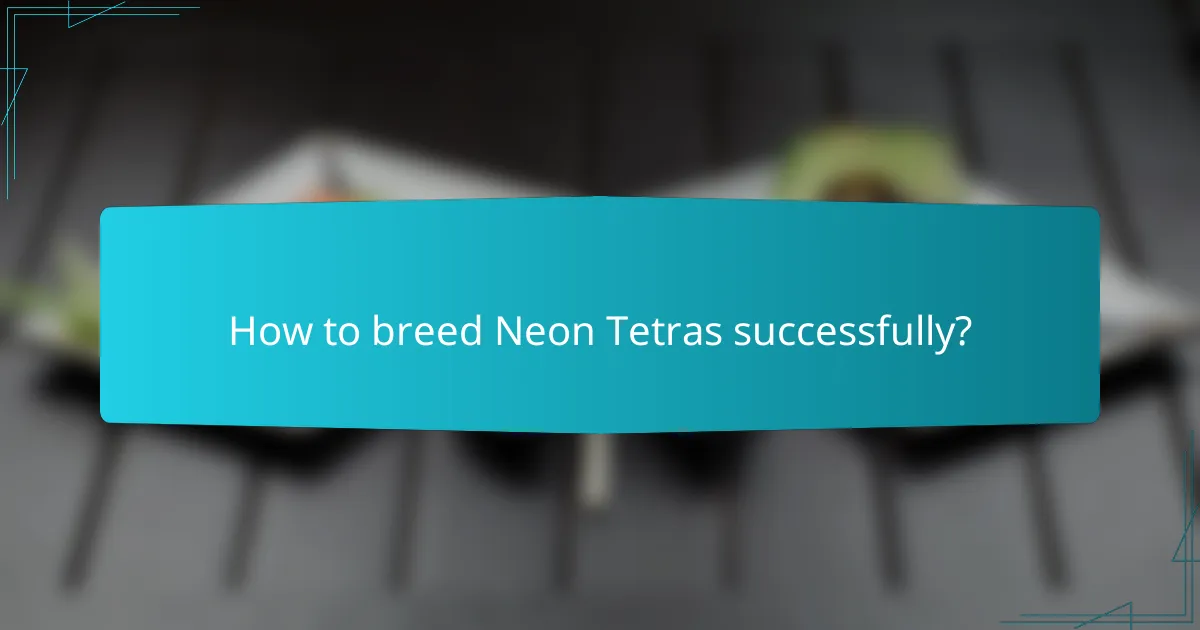
How to breed Neon Tetras successfully?
To breed Neon Tetras successfully, create a suitable environment that mimics their natural habitat, ensuring optimal conditions for spawning. Focus on water quality, tank setup, and specific spawning conditions to encourage breeding behaviors.
Breeding tank setup
Set up a dedicated breeding tank that is around 10 to 20 gallons in size, filled with soft, slightly acidic water. Use a sponge filter to maintain gentle water flow and avoid disturbing the eggs.
Add fine-leaved plants or spawning mops to provide hiding spots for the eggs and fry. Keep the tank dimly lit to create a comfortable environment that encourages the Neon Tetras to spawn.
Spawning conditions for Neon Tetras
Maintain a water temperature between 75°F and 80°F (24°C to 27°C) and a pH level of 6.0 to 7.0 for optimal spawning conditions. Regular water changes can help keep the environment stable and clean.
Introduce a breeding pair into the tank during the early morning hours, as this is when they are most likely to spawn. Monitor the tank closely, as the female will lay eggs that the male fertilizes shortly after.
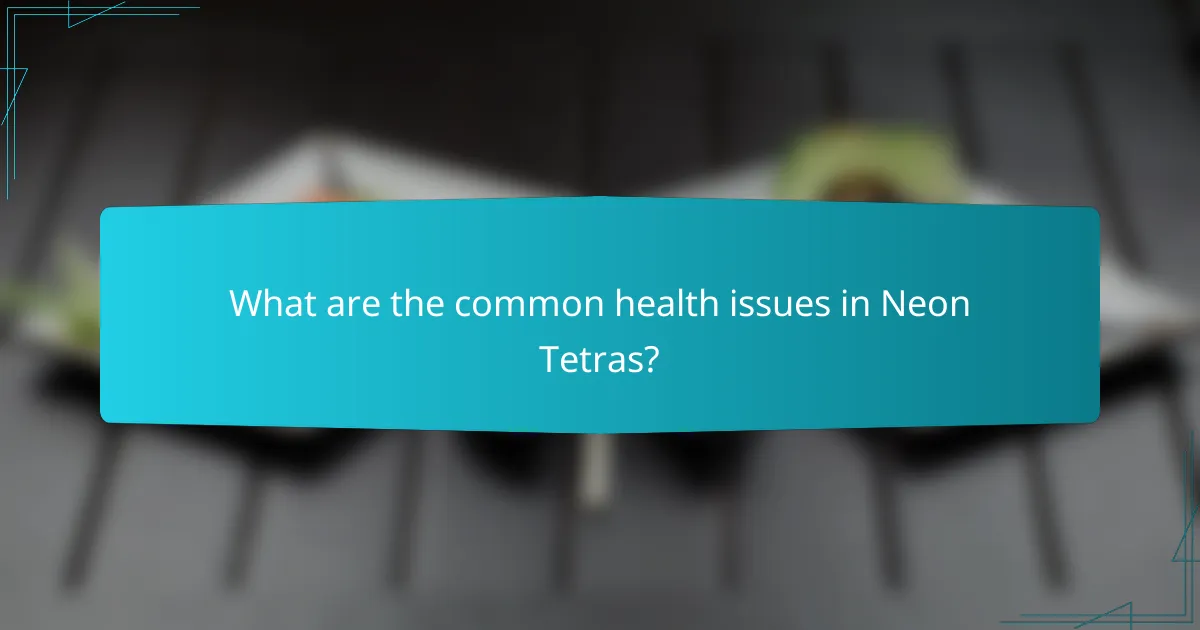
What are the common health issues in Neon Tetras?
Neon Tetras can experience several health issues, primarily due to poor water quality, stress, and infectious diseases. Common problems include fin rot, ich, and swim bladder disease, which can significantly affect their well-being and lifespan.
Signs of illness in Neon Tetras
Identifying illness in Neon Tetras involves observing changes in behavior and physical appearance. Signs include lethargy, loss of appetite, frayed fins, and unusual swimming patterns, such as floating at the surface or sinking to the bottom.
Additionally, look for discoloration or white spots on their bodies, which may indicate infections or parasites. Regular monitoring of their environment and behavior can help catch these issues early.
Treatment options for Neon Tetras
Treatment for Neon Tetras varies based on the specific health issue. For fin rot, improving water quality and using aquarium salt can promote healing. In cases of ich, raising the water temperature and adding medication specifically for parasites is often effective.
For swim bladder disease, adjusting feeding practices and ensuring a balanced diet can help. Always consult with a veterinarian or an experienced aquarist for tailored advice and treatment plans to ensure the best outcomes for your fish.

How to choose the right Neon Tetra variants?
Choosing the right Neon Tetra variants involves considering their color patterns, size, and compatibility with other fish. Look for vibrant colors and ensure they fit well within your aquarium’s ecosystem.
Popular Neon Tetra color variations
Neon Tetras are known for their striking colors, primarily featuring a bright blue body with a red stripe running from the middle to the tail. Other popular variations include the Golden Neon Tetra, which has a yellowish hue, and the Black Neon Tetra, characterized by its darker tones and distinctive patterns.
When selecting color variations, consider how they will contrast with your aquarium’s background and other fish. A mix of different colors can create a visually appealing tank, enhancing the overall aesthetic.
Differences between Neon Tetras and Cardinal Tetras
Neon Tetras and Cardinal Tetras are often confused due to their similar appearances, but they have distinct differences. Neon Tetras are generally smaller, reaching about 1.5 inches in length, while Cardinal Tetras can grow slightly larger, up to 2 inches.
In terms of coloration, Cardinal Tetras display a more vibrant red stripe that extends from the head to the tail, whereas Neon Tetras have a shorter red stripe. Additionally, Cardinal Tetras tend to prefer slightly warmer water temperatures, making them more sensitive to changes in their environment.

What are the benefits of keeping Neon Tetras?
Keeping Neon Tetras offers vibrant colors, small size, and a community-friendly nature, making them an excellent choice for both novice and experienced aquarists. Their peaceful demeanor and adaptability enhance the beauty and harmony of any aquarium setup.
Visual appeal in aquariums
Neon Tetras are renowned for their striking blue and red coloration, which adds a lively touch to aquariums. Their small size, typically around 1 to 1.5 inches, allows for easy integration into various tank sizes, from small nano tanks to larger community setups.
To maximize their visual impact, consider keeping them in groups of six or more. This not only showcases their colors but also encourages natural schooling behavior, creating a dynamic and captivating display in your aquarium.
Behavioral traits of Neon Tetras
Neon Tetras are known for their peaceful and social behavior, making them ideal for community tanks. They thrive in groups, exhibiting schooling behavior that enhances their overall well-being and reduces stress.
When introducing Neon Tetras to a tank, ensure they are housed with other non-aggressive species to maintain a harmonious environment. Avoid pairing them with larger or more aggressive fish, as this can lead to stress and potential harm to the Tetras.

What are the best products for Neon Tetra care?
The best products for Neon Tetra care include suitable aquarium equipment and high-quality fish food. These essentials help maintain a healthy environment and ensure proper nutrition for these vibrant, community-friendly fish.
Recommended aquarium equipment
For Neon Tetras, a well-maintained aquarium is crucial. A tank size of at least 10 gallons is recommended to provide ample swimming space and maintain stable water parameters. Use a reliable filtration system to keep the water clean and a heater to maintain a temperature range of 22-28°C (72-82°F).
Additionally, consider adding live plants and soft substrate to mimic their natural habitat. Plants not only provide hiding spots but also help improve water quality. A gentle filter flow is ideal, as strong currents can stress these small fish.
Top-quality fish food brands
Feeding Neon Tetras a balanced diet is essential for their health and vibrant colors. High-quality flake foods specifically formulated for tropical fish are a great choice. Brands like Tetra, Hikari, and Omega One offer nutritious options that meet their dietary needs.
In addition to flakes, supplement their diet with frozen or freeze-dried foods such as brine shrimp or daphnia. This variety promotes better health and enhances coloration. Aim to feed small amounts 1-2 times daily, ensuring they consume the food within a few minutes to prevent water quality issues.
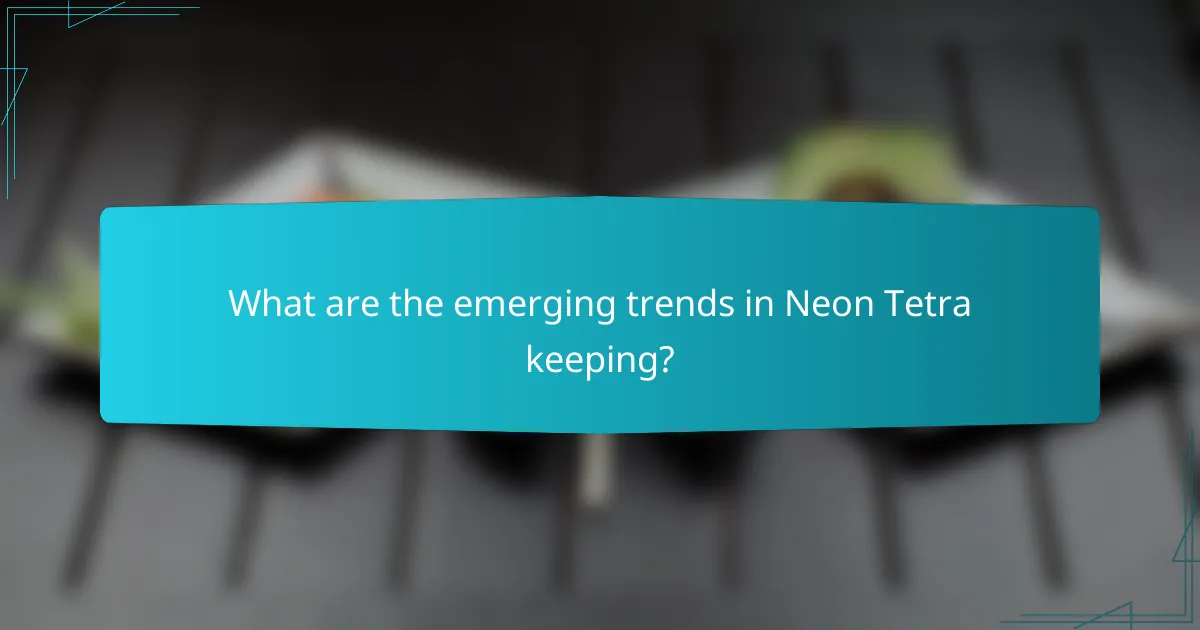
What are the emerging trends in Neon Tetra keeping?
Emerging trends in Neon Tetra keeping focus on innovative aquarium designs, improved water quality management, and enhanced community tank setups. Aquarists are increasingly adopting modern techniques to create vibrant, healthy environments that cater to the needs of these small, colorful fish.
Innovative aquarium designs
Innovative aquarium designs for Neon Tetras emphasize natural aesthetics and functionality. Many hobbyists are incorporating live plants, driftwood, and rocks to mimic the fish’s natural habitat, which enhances their colors and overall well-being.
Using aquascaping techniques, such as the rule of thirds and layering, can create visually appealing layouts. Consider using a variety of plant species that thrive in similar water conditions, ensuring a balanced ecosystem that supports both plant and fish health.
Additionally, integrating technology like LED lighting can enhance the vibrancy of Neon Tetras. Adjustable lighting systems allow for simulating day and night cycles, which can reduce stress and promote natural behaviors.





